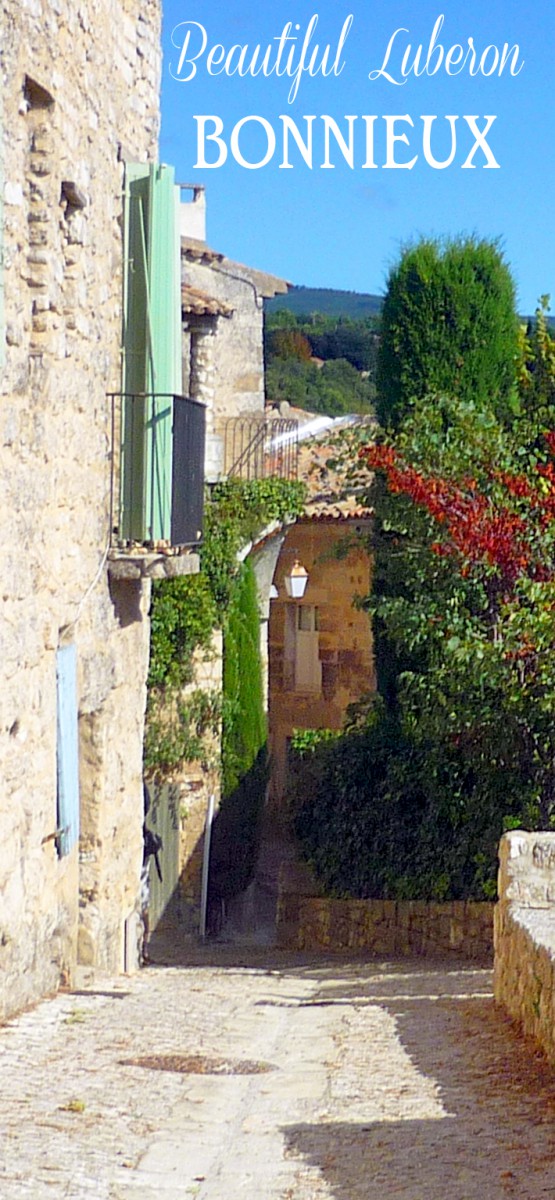As I stepped into the heart of Provence on a sun-drenched October day, the quaint village of Cabrières-d'Avignon unveiled itself as nothing short of a revelation.
There was something about the warmth of the sun, the serene atmosphere, and the timeless beauty of the village that immediately captivated me.
My first visit to this enchanting place, far removed from the hustle and bustle of city life, felt like uncovering a well-kept secret nestled amidst the vibrant landscapes of the Luberon.
With every stone-laden path, every whisper of the past, and the undeniable charm of the village, Cabrières-d'Avignon offered a profound sense of discovery.
It was as if the village, with its rich tapestry of history, culture, and natural beauty, had been waiting to share its stories with those willing to listen.
Join me as I recount my journey through this picturesque Provençal gem, where every corner held a new surprise, and every moment felt like stepping through the pages of a story long cherished but only just beginning to unfold.
Watch this short video on the Luberon!
Plan your trip
- 🛏 Find the best accommodations in the Luberon on Booking.com
- 🚙 Rent a car in Aix-en-Provence or Marseille-Provence Airport
- 🙋♀️ Get the PASS CÔTE D'AZUR and take your pick from more than 100 amazing experiences!
- 🤩 Visit the beautiful Provençal region of Luberon
- 🚐 Join a 6-hour tour of Lourmarin, Bonnieux, Roussillon, and Gordes by air-conditioned minibus
- 🚘 Discover Provence in a 2CV. Stroll along exceptional roads and enjoy a piece of Luberon all to yourself!
- 🥗 Experience a black truffle hunting tour in a Luberon plantation
- 📚 Read the DK Eyewitness Provence and the Côte d’Azur Travel Guide
- 🗺 Download the touristic map of Cabrières-d'Avignon
- 🚻 Public toilets are located at the Grand Rue near the public librairy.
- 🚗 Park at the entrance to the old village: car park behind the town-hall (Cours Jean Giono and ).
Cabrières-d'Avignon: A Bit of History
The first mention of the village is due to the castle's construction in the 11th or 12th century by the Adhémar family.
However, the history of Cabrières is marked by the massacre of April 1545, during the campaign of Maynier d’Oppède against the Waldensians.
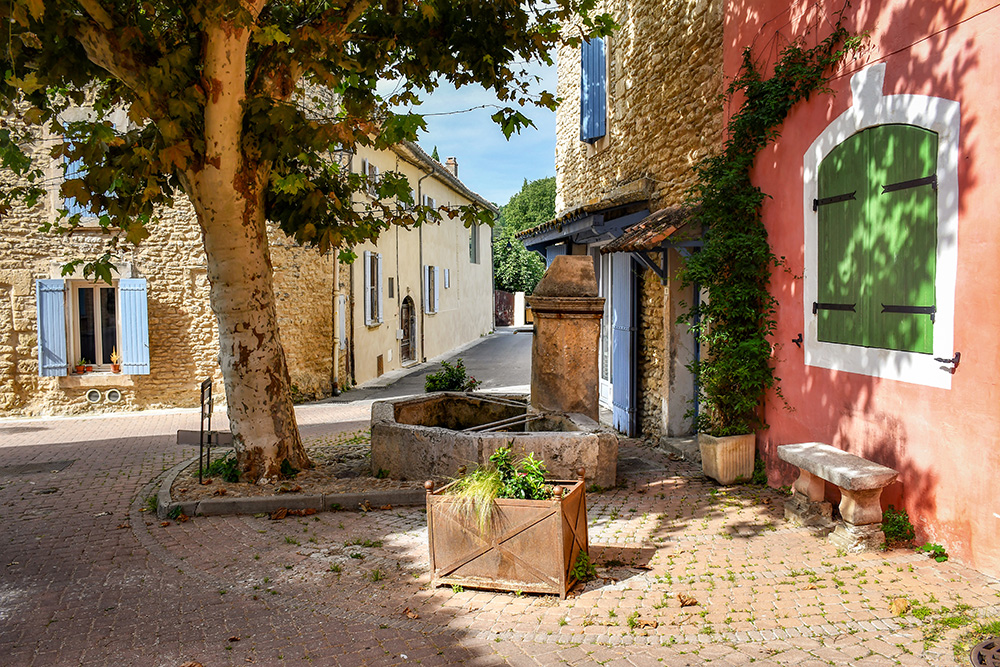
Fontaine-Basse © French Moments
The Waldensians Massacre
In 1490, Cabrières was in the hands of Giraud d'Ancézune, Baron of Caderousse. To exploit his lands, he brought in Waldensian families from the Italian Alps.
The castle served as their refuge.
But after the Waldensians' capitulation, the population was slaughtered, and the village was razed.
The few survivors were sent to the galleys.
A stele near the entrance to the castle briefly presents the end of the Waldensian story in the Luberon.

The stele about the Waldensians Massacre © French Moments
Cabrières from the Papal lands to France
Cabrières d’Avignon was part of the Comtat Venaissin and was attached to France on the 18th of August 1791.
The village was included in the Vaucluse département from its creation in 1793.
Electricity arrived in the village in 1923.
As for the drinking water network, it was installed in 1938.
Up to now, Cabrières d’Avignon has curiously remained apart from the overall transformation of the Luberon into a luxury destination that has affected the nearby villages of Gordes, Ménerbes, and Lacoste.
The inhabitants enjoy an exceptional quality of life and a relatively rare tranquillity in this highly touristic region of the Luberon, even in summer.
However, the population has continually grown since 1945.
From 615 inhabitants in 1946, it has increased to 1800 inhabitants in 2021.

Chemin des Pasquiers © French Moments
Where does the name Cabrières come from?
There are two possibilities as to explain the origin of the name Cabrières.
The first is that "cabrières" refers to the old "quarries" (Carrières) found in the area.
Another version suggests that Cabrières translates to "goat stable," because "goat" in Provençal is said "Cabro."
Indeed, the coat of arms of Cabrières d’Avignon features a standing goat accompanied by a star from the arms of the Lords of Les Baux.
From the 15th century onwards, the village was successively named "Capreris", "Capriera", "Cabrieras" and "Cabreria" on the map of the diocese of Cavaillon in the 16th century.
The name Cabrières began to be supplemented by "du Comtat", meaning that it belonged to the Holy See. Thus, the word "d’Avignon" comes from its belonging to the Comtat Venaissin.
It also differentiates the village from Cabrières-d'Aigues, also located in the Vaucluse département.
It was in 1918 that the commune officially took the name of Cabrières-d'Avignon.

Grand Rue © French Moments
The Discovery Guide of Cabrières-d'Avignon
Here's some tourist information to help you explore the Provencal village.
🎦 Check out my guided walk on YouTube to explore Cabrières-d'Avignon with me:
Understanding the Village
In the Luberon region, where each village is perched to defend itself in the past better, Cabrières-d'Avignon is an atypical village because it is almost completely flat.
Today, Cabrières offers the tranquillity of a Provençal village, with streets lined with dry stone walls connecting little squares and fountains.
The village is home to two distinctly different monuments: the church and the castle.

The Castle of Cabrières-d'Avignon © French Moments
It is said that Cabrières d'Avignon offers two faces to discover.
To the south: the fields and orchards
The "cultivated Provence" in the Calavon plain and the harsh, dry Provence on the scrubland slopes of the Monts de Vaucluse.
The southern part of the commune is mainly made up of agricultural land.
This territory is located on the heights of the Calavon plain.
Cherries, almonds, olives, and asparagus are cultivated here.
The vineyard produces AOC Ventoux wines.

Rue de l'église © French Moments
To the north: the garrigue
The northern part of the village, mainly composed of woods and scrubland (la garrigue), is located on the Monts de Vaucluse.
Truffles are cultivated there thanks to the presence of numerous oak groves.

The forest near Cabrières-d'Avignon © French Moments
In 1860, seeds of the Lebanon cedar were sown north of the village on a site that would become the Forêt des Cèdres (the cedar forest).
It's a magnificent site that spans a little over 5 hectares and houses a refreshment stand and a fitness trail.
Grand Rue
The Grand Rue (High Street) is the backbone of the village.
Most of the village's shops are found here.

Grande Rue © French Moments
Place de l'Église
The Place de l'Église is a large square bordered by the Saint-Vincent church.
In the square stands the war memorial, erected in 1921.
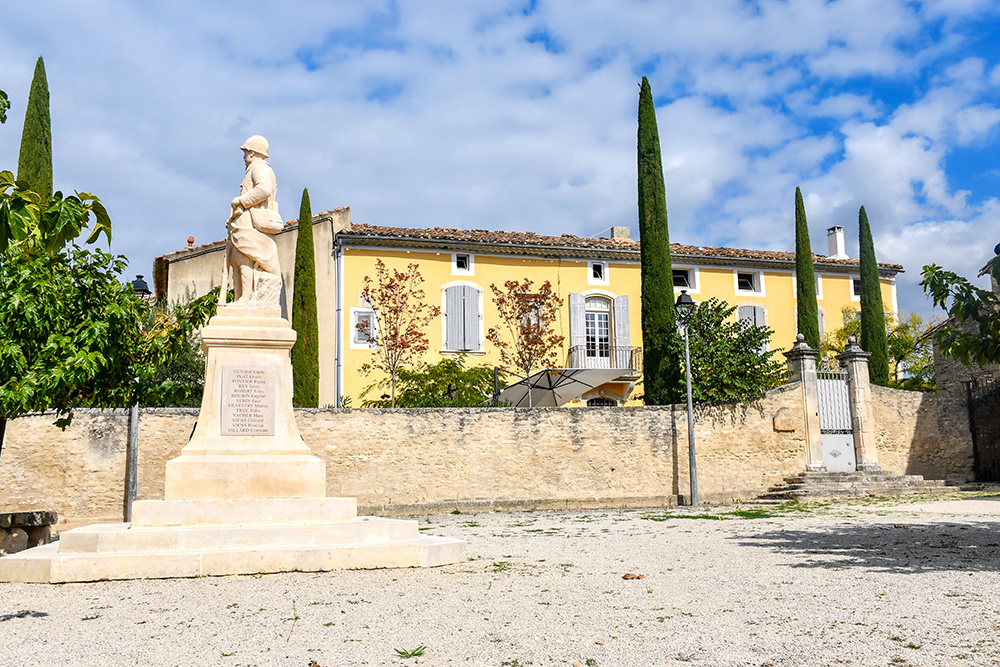
The War Memorial, Place de l'église © French Moments
The parish church of Saint-Vincent is in the Provençal style.
It was rebuilt after the Wars of Religion and consecrated in 1587.

The church of Saint-Vincent © French Moments
The beautiful house opposite is the old presbytery of the church, built in 1661.

The old presbytery © French Moments
Fontaine-Basse
At the end of the Grand Rue is one of the most charming corners of Cabrières: the lower fountain or Fontaine-Basse.

Fontaine Basse © French Moments
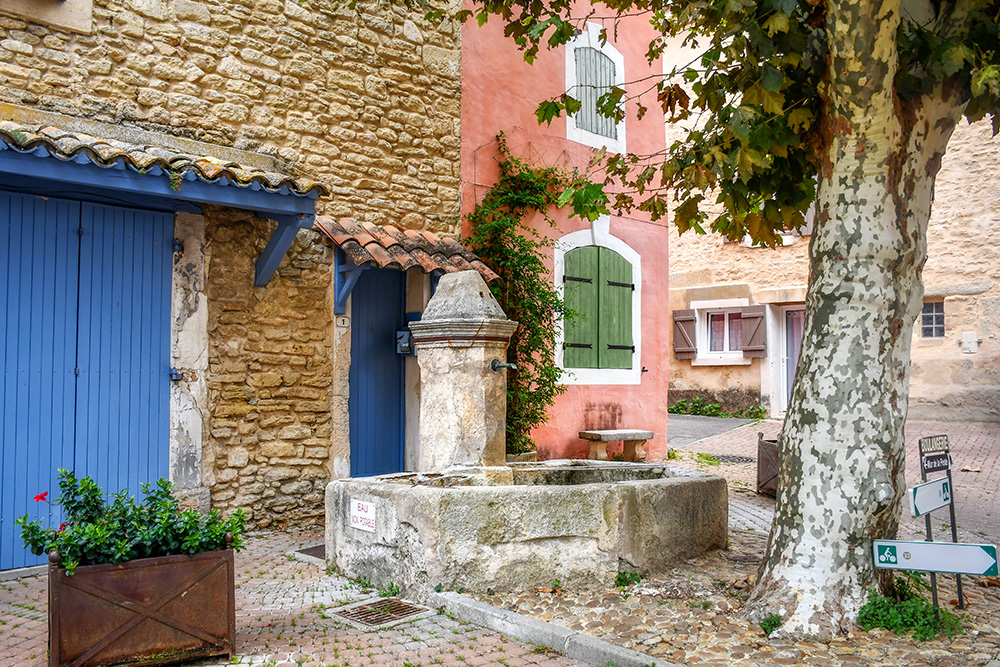
The fountain © French Moments

Fontaine-Basse © French Moments
Place Haute
The square of Place Haute is another charming spot in Cabrières.
There is found the second washhouse of the village, superbly restored.

Place Haute © French Moments

Place Haute © French Moments
The Castle of Cabrières
The castle of Cabrières was built in the 11th century by the Adhemar family, who were the Viscount of Cavaillon, that is, the first hereditary Counts of Orange.

The castle of Cabrières © French Moments
Then, in the 14th century, it passed to Henri de Chiabeau.
His daughter, Laure, was born in 1314, and some historians claim she could be the legendary Laura of Petrarch. To learn more about Petrarch and Laura, read my blog post about Fontaine-de-Vaucluse.

Could Petrarch's Laura come from Cabrières?
The castle was destroyed during the Waldensians massacres of 1545.
A few years ago, the ramparts and the castle were in a pity state, but they have since been renovated.
Today, the castle is a private estate that is not open to visitors. It was owned until recently by a wealthy and discreet Scottish family who sold it for 5.4 million euros to a financial group that wishes to transform it into a 5-star hotel.

The entrance to the Castle of Cabrières-d'Avignon © French Moments
The fortifications
Walk on the Chemin de la Pourtalette for a few metres to discover the western ramparts of the castle.

The fortifications © French Moments
This is an old fortification (13th or 14th C) of a vaguely rectangular plan whose current average height is 8 metres.
A circular tower supported each angle of the fortifications, but the western wall here has an additional one.
You can see numerous gun ports and arrow slits.
A tour around the castle
If you go round the outside via Chemin de la Pourtalette and Rue Eustache Marron, you will see :
- the south side, which has a gateway topped with a gold caber; through the gateway, you can see the Renaissance-style dwelling and its hexagonal staircase tower.
- a good section of wall on the west side, with a gate adorned with a red griffin.
- the mighty north-west tower, which has been converted into a dovecote.
- another large section of wall to the north, in a fine elevation;
- the north-east tower, which is particularly imposing and contains numerous fire pits.
The Rue Eustache Marron that runs along the northern part of the castle has been named after the leader of the Waldensian rebellion in 1545.

The ramparts © French Moments
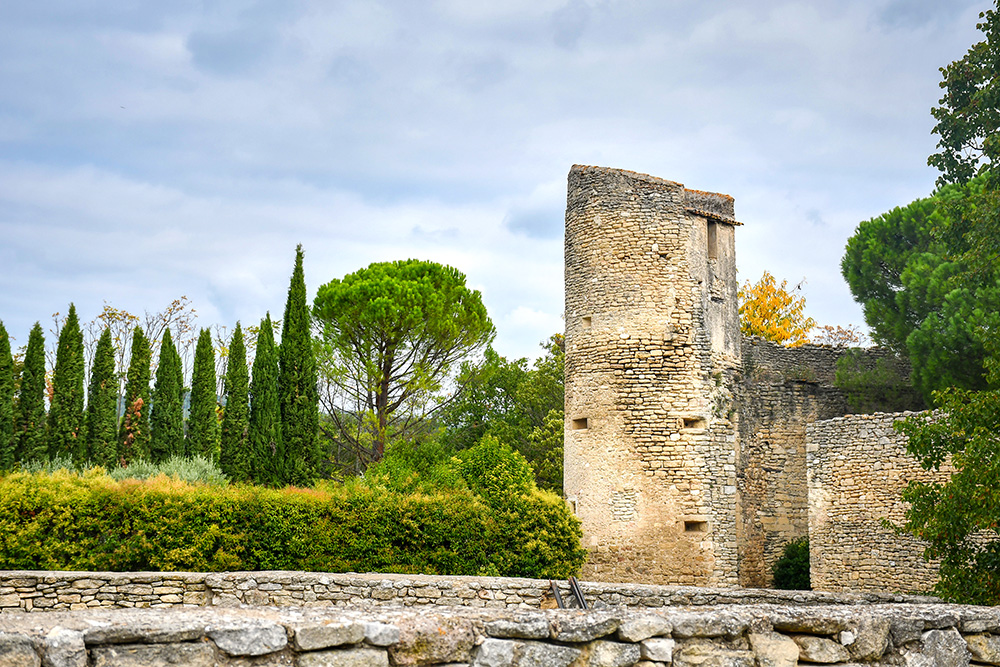
The former dovecote © French Moments
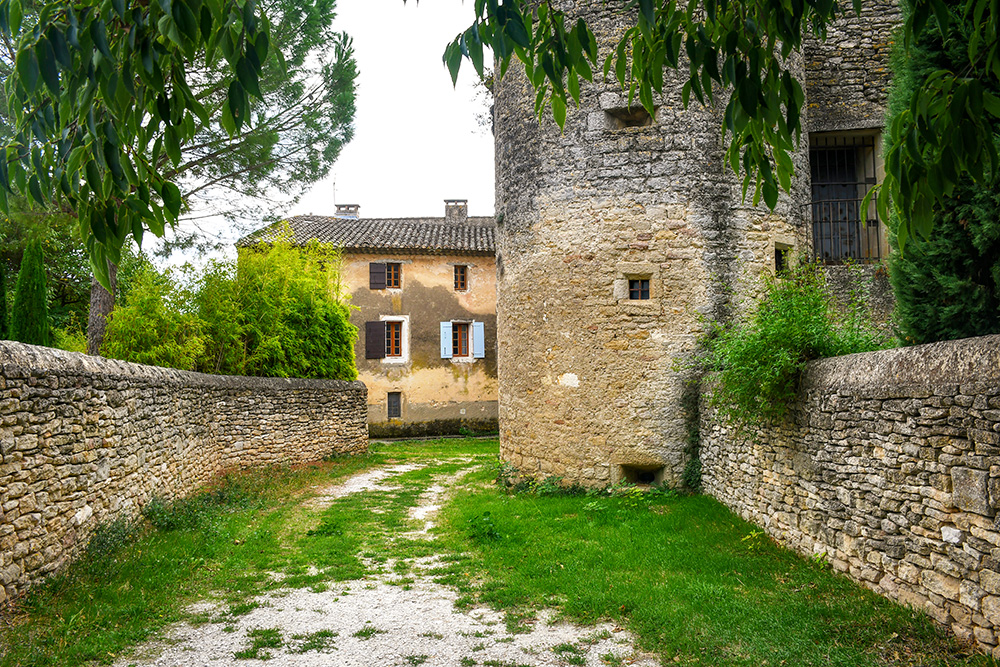
The ramparts (Rue du Vieux Four) © French Moments
The Four Wash-houses
The village still has four old wash-houses (lavoir) that have been remarkably restored:
- Fontaine-Basse
- Rue du Château
- Place Haute
- Chemin des Pasquiers (lavoir du four)
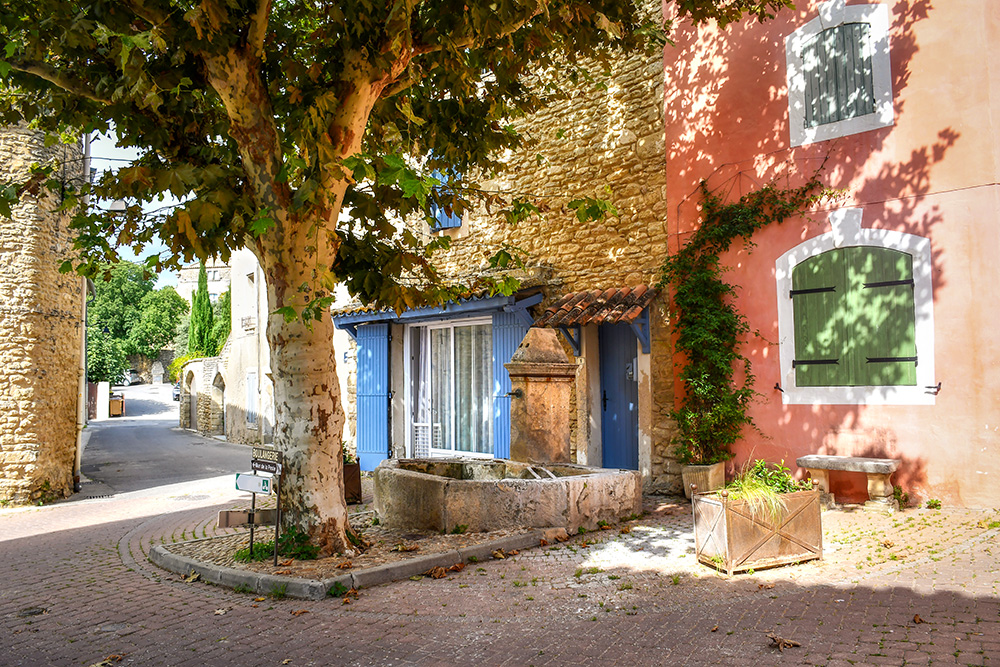
Fontaine Basse © French Moments
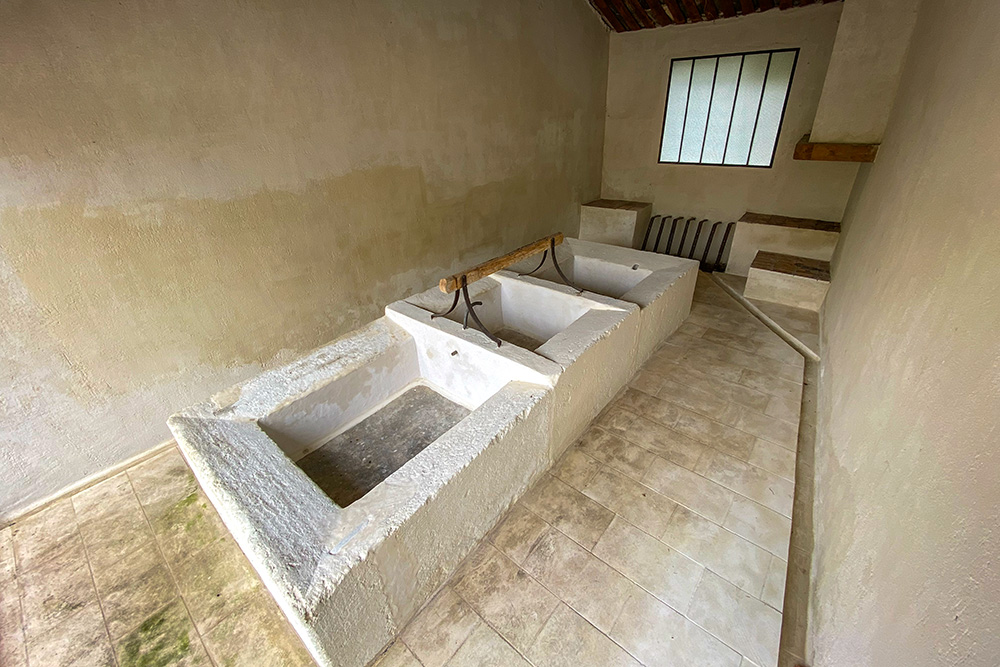
Wash-house of Rue du Château © French Moments

Wash house of Place Haute © French Moments

Lavoir du Four © French Moments

Fontaine du Four © French Moments
In addition, there is a beautiful fountain at the intersection of Route de Lagnes and Grand Rue and the entrance to the old village.

Fountain in Route de Lagnes and Grand Rue © French Moments
Most of them have retained their original features: three basins that were used for washing and rinsing, and a wooden beam was used to wring out the laundry.

Lavoir du Four © French Moments
Minor Heritage Features
In Cabrières-d'Avignon, you will encounter a rich tapestry of minor heritage, including old wells, ancient olive groves enclosed by dry stone walls, and commemorative plaques, all of which weave the fabric of local history and everyday life into the picturesque landscape.

The old well, Rue de la Baronnette © French Moments

Carriage entrance, Chemin des Pasquiers © French Moments
Finally, here are a few views of the village's old streets and squares.

Near fontaine du four © French Moments

Rue des Pasquiers © French Moments

The local butcher's, Grand Rue © French Moments

Rue Neuve © French Moments

Chemin des Pasquiers © French Moments
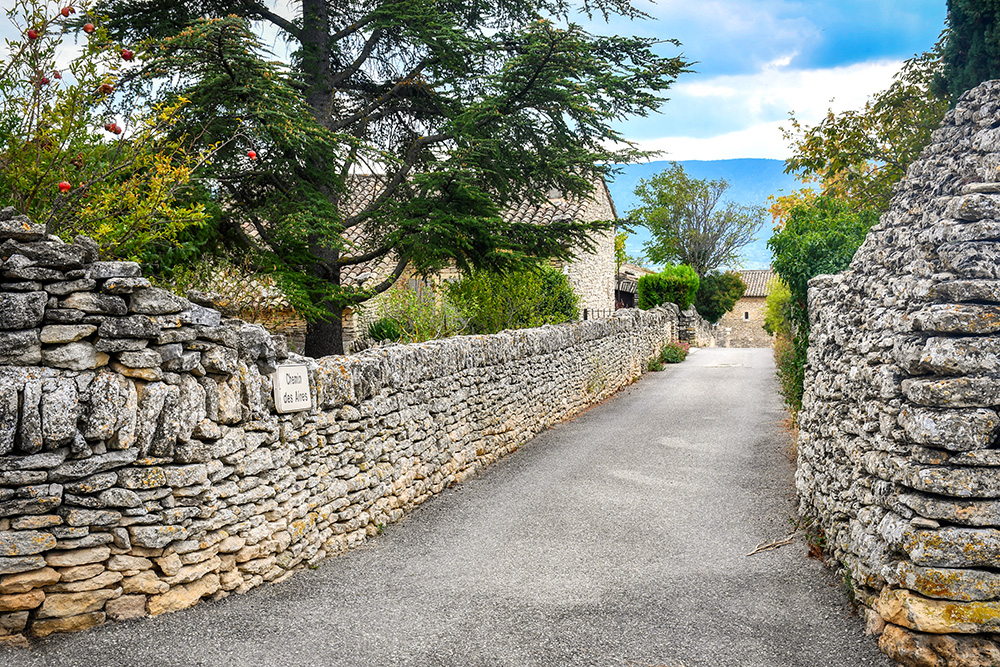
Chemin des Aires © French Moments

Rue Haute © French Moments

Rue de la Baronette © French Moments
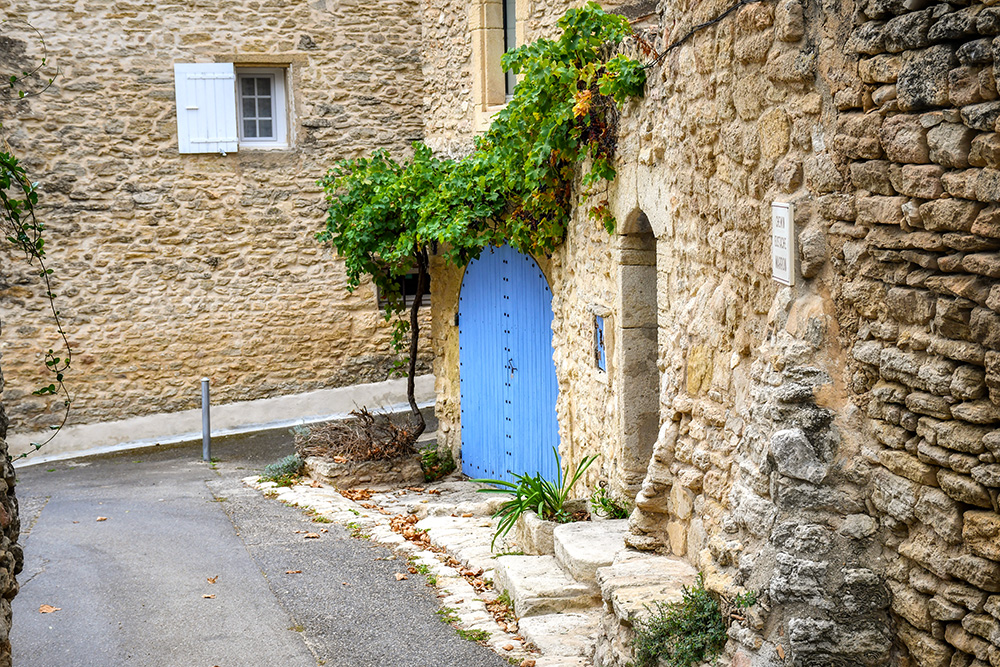
Rue Eustache Marron © French Moments

Impasse de la Pourtalette © French Moments

Grand Rue © French Moments
Find out more
Here are some pages from our blog and other websites to find out more about this Provencal destination.
- Discover the hilltop villages of the Luberon
- Explore the neighbouring villages of Gordes and Fontaine-de-Vaucluse
- Find out more about Provence-Alpes-Côte d'Azur
- The official tourist office of the area
- The official website of the municipality
Where to stay in Cabrières-d'Avignon
Cabrières-d'Avignon and surroundings have a high capacity for holiday accommodation. The commune has hotels, bed and breakfasts (covering all price ranges), estate agencies offering seasonal rentals and gîtes.
Click here to book your accommodation in the Luberon or browse the map below:
What to do in the Luberon
Be inspired by a list of things to do in the Luberon:
Pin Cabrières-d'Avignon on Pinterest
